
Happy New Year! This picture is of the first sunrise of 2011, courtesy of the Mt. Fuji Live Camera


Happy New Year! This picture is of the first sunrise of 2011, courtesy of the Mt. Fuji Live Camera

But back in the 16-bit era, we usually weren't so lucky. That's why I was pleased when I recently discovered three SNES games that featured plenty of Japanese culture: Kendo Rage, Pocky & Rocky, and Legend of the Mystical Ninja.

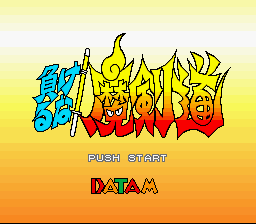
Kendo as a martial art has nothing much to do with actual sword fighting. I would describe it as taking turns hitting each other on the head with sticks. I'm sure it evolved from samurai sword practices and such, but all it entails is wearing armor and smacking each other with bamboo practice swords using only vertical slashes. It also involves lots of shouting too. When I was an assistant English teacher in Himeji, I would go around and visit the kids in their various club activities after school. The first one I visited was the volleyball club. I was hoping to get a volleyball game going, but all they did was practice hitting the ball over the net over and over again. Boring. I didn't even want to try playing with the judo club kids because they'd probably fling me and hurt me. Well, maybe they couldn't fling me because I weighed 175 pounds at the time (what I wish I weighed today). Anyhow, so I tried playing with the kendo kids. They dressed me in the mask and gear and all that. So when it came time to spar or whatever, this girl came at me with her sword and I got all Ben Kenobi on her. I held my sword horizontally to block the blow, then swung our swords 270 degrees to the right and tapped her on her thigh. Her: "Oh, you can't do that." Me: "Why not? This is sword fighting." Her: "No, this is kendo. You attack like this (vertically)." At least that's how I think the conversation went. I wasn't as good at understanding Japanese as I am now, and this was back ten years ago in 2000. That girl is in her 20s now and could be married for all I know. So anyhow, that was my experience with kendo. Vertically chopping each other ont the head or shoulders.
But I guess when you are proficient with kendo, you can get to the part where you can hit people by just slashing the sword in the air and stuff flies from it or something. At least that's what happens in Kendo Rage, known as Makeru na! Makendou in Japan. The gameplay reminds me very much of the Valis series for the PC Engine. In the Japanese version, the main character is named Mai. But possibly because the thought of an anime character that is Japanese and has blonde hair may cause American's heads to explode like in that movie Scanners, she was changed to an American girl named Jo who is visiting Japan for a summer exchange program to study kendo. Amazingly enough, the setting of the story remains in Japan, and stuff like Japanese text on the sides of the buses and even the voice remains in Japanese.
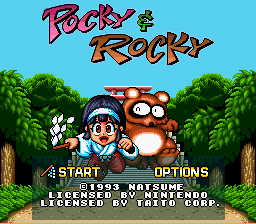
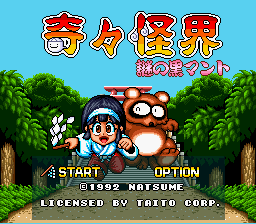
Pocky & Rocky is the English name for Kiki Kaikai: Nazo no Kuro Manto. I'd known of the game Pocky & Rocky since the '90s by name only, and I judged the game to be some dumb kids game by the name. I was wrong to do so! The game's main character Sayo-chan (or Pocky in the English version) is a miko, or shrine maiden/shaman woman. I'm no expert on the Shinto religion, but I'd say that they are similar to nuns, as they are virgins consecrated to serving at a shrine. Wearing loose-fitting, flowing red pants and a white coat, miko are easily identifiable in so many anime and video games. Sakura in Urusei Yatsura, Rei in Sailor Moon, Kikyo in Inuyasha, the Hiiragi twins in Lucky Star, and Koyori in Sengoku Blade are popular examples. As typical of miko characters, Sayo-chan has two main weapons:
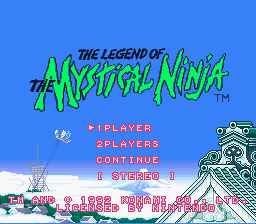
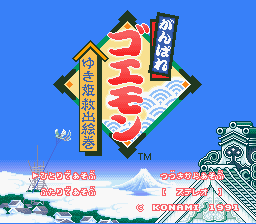
Legend of the Mystical Ninja is actually Gambare Goemon on the Super Famicom. I'd known of the Gambare Goemon series for quite a while, but I had no idea the first one was released domestically. The game series is based off of the historical folk hero Ishikawa Goemon, a legendary bandit who is in many way's the Japanese version of England's Robin Hood who robbed from the rich and gave to the poor. He comes from the Sengoku Period (15th to the 17th centuries), which I find to be the most interesting era of Japanese history to study. Studying the life of Oda Nobunaga during this period is one of the many things that really sparked my fascination with Japan. Read up about Goemon on Wikipedia. Goemon is a cultural icon for Japan. When I first heard of the Goemon games, I first thought of the Goemon character from the anime Lupin III. It turns out that Lupin's friend Goemon is a descendent of the original Goemon, which this Konami game series is based off of.
To insult our intelligences, however, the character names for Goemon and Ebisumaru (character based off of Nezumi Kozo) were inexplicably changed to Kid Ying and Dr. Yang in the domestic Legend of the Mystic Ninja. I think this is so stupid because it plays on the whole "all Asians are basically the same" mentality because yin and yang are the concepts behind Taoist philosophy, which, as I hope you already know, is a Chinese philosophy. That's not to say that China had quite an influence over Japan (and Korea and Vietnam, for that matter), but to name the characters in an obviously Japanese setting after Chinese concept words is so ignorant. Nevertheless, we were lucky to at least get this Goemon game for the SNES locally. There weren't any English domestic Goemon games released until the N64.
 Go back to the "Greg's Life" Table of Contents
Go back to the "Greg's Life" Table of Contents
"When Abraham Lincoln fought against giant scorpions in the Vietnam War, he always rode a pony." ---TheOatmeal.com
mail: greg -atsign- stevethefish -dot- net